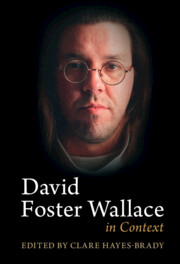Book contents
- David Foster Wallace in Context
- David Foster Wallace in Context
- Copyright page
- Contents
- Figures
- Contributors
- Acknowledgments
- Abbreviations
- Introduction
- Part I Contexts
- Part II Ideas
- Part III Bodies
- Part IV Systems
- Chapter 26 Infinite Jest as Opiate Fiction
- Chapter 27 David Foster Wallace and Racial Capitalism
- Chapter 28 Language and Self-Creation
- Chapter 29 Very Old Land
- Chapter 30 David Foster Wallace’s Ecologies
- Chapter 31 “I Could, If You’d Let Me, Talk and Talk”
- Chapter 32 David and Dutch
- Chapter 33 David Foster Wallace and Publishing
- Chapter 34 Author Here, There and Everywhere
- Works by David Foster Wallace
- Bibliography of Secondary Sources
- Index
Chapter 30 - David Foster Wallace’s Ecologies
from Part IV - Systems
Published online by Cambridge University Press: 18 November 2022
- David Foster Wallace in Context
- David Foster Wallace in Context
- Copyright page
- Contents
- Figures
- Contributors
- Acknowledgments
- Abbreviations
- Introduction
- Part I Contexts
- Part II Ideas
- Part III Bodies
- Part IV Systems
- Chapter 26 Infinite Jest as Opiate Fiction
- Chapter 27 David Foster Wallace and Racial Capitalism
- Chapter 28 Language and Self-Creation
- Chapter 29 Very Old Land
- Chapter 30 David Foster Wallace’s Ecologies
- Chapter 31 “I Could, If You’d Let Me, Talk and Talk”
- Chapter 32 David and Dutch
- Chapter 33 David Foster Wallace and Publishing
- Chapter 34 Author Here, There and Everywhere
- Works by David Foster Wallace
- Bibliography of Secondary Sources
- Index
Summary
Wallace’s landscapes are haunted by capitalist interventions in the natural world, from the black sand of the Great Ohio Desert to the Great Convexity/Concavity that sits like a pustule between the United States and Canada. This chapter considers Wallace’s writing as an ecocritical gesture that connects human solipsism, hypercapitalism and the despoiling of the natural world. In tracing this connection, the chapter operates on the central theme of disgust, a recurrent and powerful motif throughout Wallace’s body of work. Working alongside the chapter on regional geographies, the chapter shows how Wallace troubled and complicated the regional archetypes that populate his writing by using images of the unheimlich and the grotesque, uniting the threatening, the decomposing and the simply absurd to highlight the depredations of the late capitalist system on the (American) landscape.
Keywords
- Type
- Chapter
- Information
- David Foster Wallace in Context , pp. 325 - 334Publisher: Cambridge University PressPrint publication year: 2022

